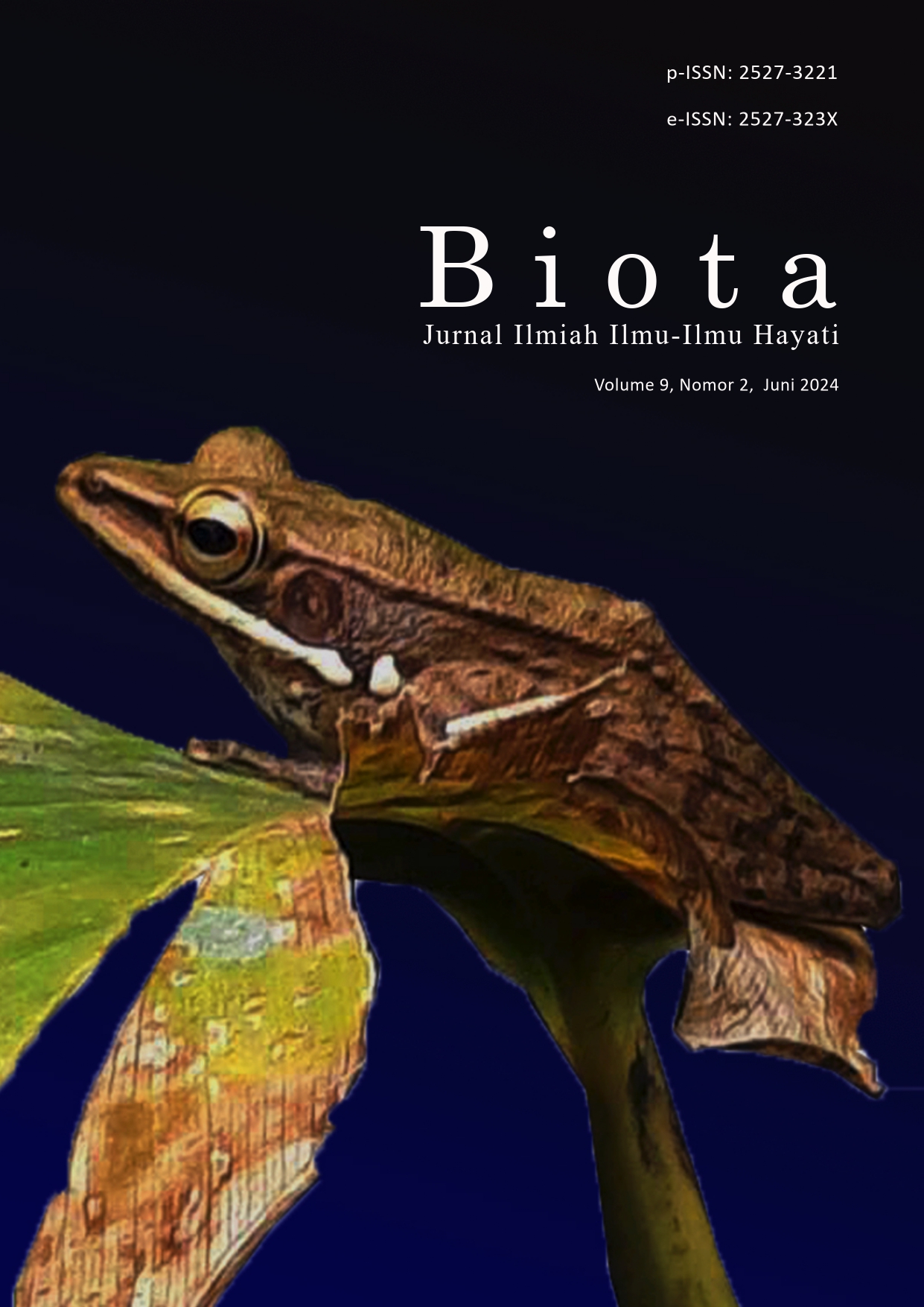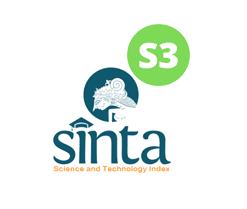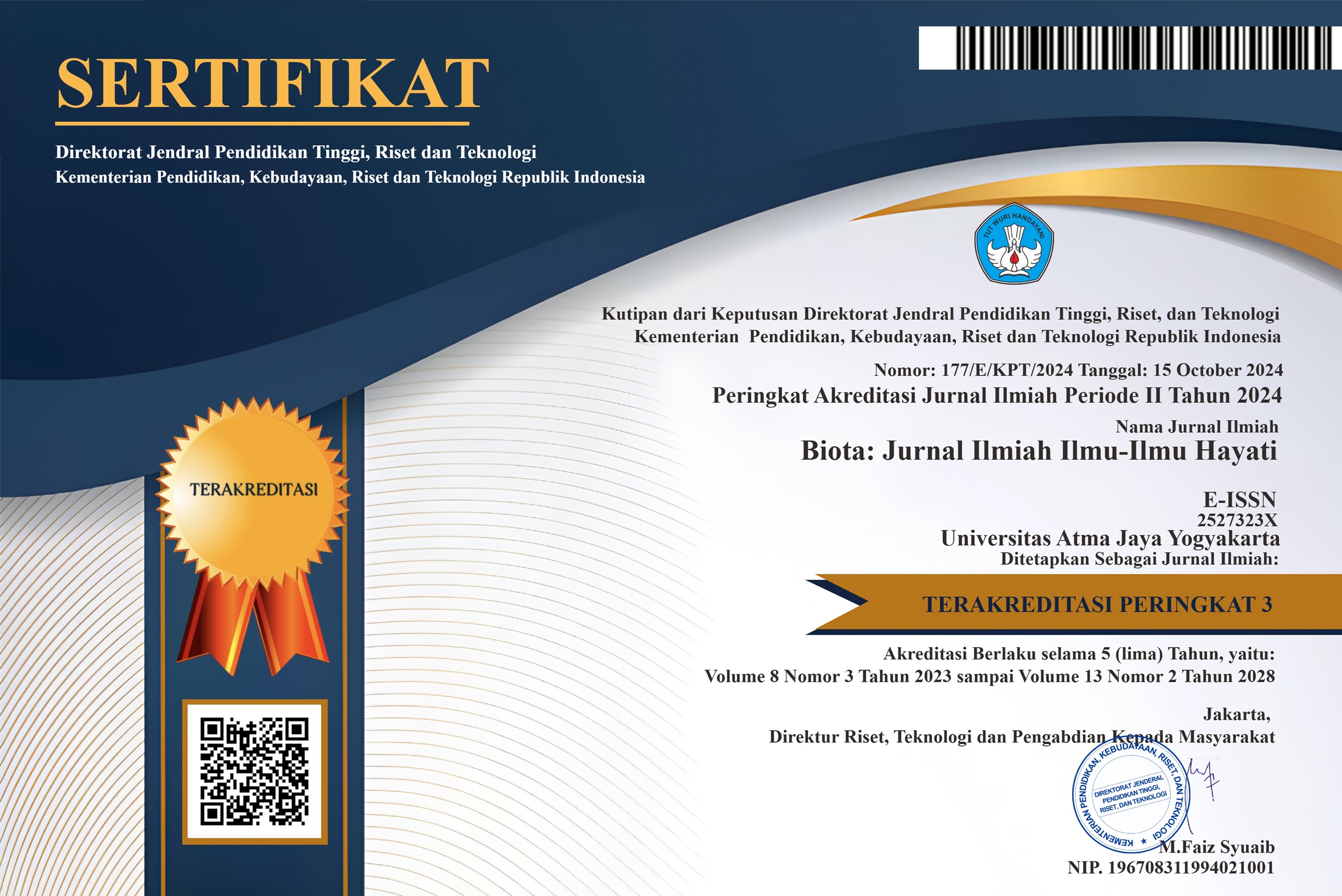Isolation And Characterization of Lactobacillus Species From Local Indonesian Cow’s Milk
DOI:
https://doi.org/10.24002/biota.v9i2.7792Keywords:
Biochemical identification, lactic acid bacteria, Limosilactobacillus fermentum, probiotics, 16S rRNA sequencingAbstract
Probiotics are a group of beneficial microorganisms that can improve the health of their host. Lactobacillus species are lactic acid bacteria that have great potential as probiotics, in which cow’s milk is a great source of lactic acid bacteria. In this study, Lactobacillus spp. were isolated from fresh local Indonesian cow’s milk. The methods used to characterize the Lactobacillus spp. were (i) biochemical tests including catalase, hemolytic and sugar fermentation tests; (ii) tolerance tests against salt (NaCl 2%, 4% and 6%), low pH (2, 3, 4, 5, 6 and 7) and temperature (7°C, 37°C and 45°C); and (iii) 16S rRNA sequencing. The isolation yielded 14 isolates matching the criteria of Lactobacillus spp. colony and cell (i.e., Gram positive rods that did not produce endospores and did not have a waxy layer covering its cell wall). Based on subsequent biochemical tests, 5 isolates were suspected as potential probiotic Lactobacillus spp. The 16S rRNA sequencing revealed that the isolate L was Limosilactobacillus fermentum. In conclusion, this study demonstrated that local cow’s milk could be used to isolate Lactobacillus spp.
References
Abdel-Daim, A., Hassouna, N., Hafez, M., Ashor, M. S., & Aboulwafa, M. M. (2013). Antagonistic activity of Lactobacillus isolates against Salmonella typhi in vitro. BioMed Research International 2013: 680605.
Anindita, N. S., Anwar, M., Widodo, Taufiq, T. T., & Wahyuningsih, T. D. (2017). Ketahanan isolat bakteri asal feses bayi terhadap variasi suhu dan pH. Proceeding Health Architecture 1(1):163-169.
Borriss, R. (2020). Chapter 7 – Bacillus. In Beneficial Microbes in Agro-Ecology. Academic Press. Cambridge.
El Kahlout, K. E. M., El-Quqa, I. M., El-Hindi, M. W., & El-Bashiti, T. A. (2018). Isolation, biochemical characterization and DNA identification of yogurt starters Streptococcus thermophilus & Lactobacillus delbrueckii ssp. Bulgaricus in Gaza strip. Advances in Microbiology 8(12): 1005-1020.
Goldstein, E. J. C., Tyrrell, K. L., & Citron, D. M. (2015). Lactobacillus species: taxonomic complexity and controversial susceptibilities. Clinical Infectious Diseases 60: S98-S107.
Halder, D., Mandal, M., Chatterjee, S. S., Pal, N. K., & Mandal, S. (2017). Indigenous probiotic Lactobacillus isolates presenting antibiotic like activity against human pathogenic bacteria. Biomedicines 5(2): 31.
Herbel, S., Vahjen, W., & Wieler, L. (2013). Timely approaches to identify probiotic species of the genus Lactobacillus. Gut Pathogens 5: 27.
Hill, C., Guarner, F., Reid, G., Gibson, G. R., Merenstein, D. J., Pot, B., Morelli, L., Canani, R. B., Flint, H. J., Salminen, S., Calder, P. C., & Sanders, M. E. (2014). The international scientific association for probiotics and prebiotics consensus statement on the scope and appropriate use of the term probiotic. Nature Reviews Gastroenterology & Hepatology 11(8): 506–514.
Jose, N. M., Bunt, C. R., & Hussain, M. A. (2015). Comparison of microbiological and probiotic characteristics of Lactobacilli isolates from dairy food products and animal rumen contents. Microorganisms 3(2): 198-212.
Liu, M., Liu, M., Yang, S., Shen, C., Wang, X., Liu, W., & Guo, Y. (2022). Fermented milk of cheese-derived lactobacillus subsp. bulgaricus displays potentials in alleviating alcohol-induced hepatic injury and gut dysbiosis in mice. Food Research International 157: 111283.
Ludwig, W., Schleifer, K.-H., & Whitman, W. B. (2015). Class I. Bacilli class. nov. In Bergey’s Manual of Systematics of Archaea and bacteria. John Wiley & Sons, Inc. New Jersey.
Martinez, R. M., Hulten, K. G., Bui, U., & Clarridge, J. E., 3rd (2014). Molecular analysis and clinical significance of Lactobacillus spp. recovered from clinical specimens presumptively associated with disease. Journal of Clinical Microbiology 52(1): 30–36.
Mithun, S., Dipak, V., & Sheela, S. (2015). Isolation and identification of lactobacilli from raw milk samples obtained from Aarey milk colony. International Journal of Scientific and Research Publication 5(4): 1.
Naghmouchi, K., Belguesmia, Y., Bendali, F., Spano, G., Seal, B. S., & Drider, D. (2020). Lactobacillus fermentum: a bacterial species with potential for food preservation and biomedical applications. Critical Reviews in Food Science and Nutrition 60(20): 3387–3399.
Nemska, V., Danova, S., & Georgieve, N. (2019). Enzyme profile of Lactobacilli from traditional Bulgarian fermented milk products. Journal of Chemical Technology and Metallurgy 54(6): 1157-1158.
Ogodo, A. C., Agwaranse, D. I., Daji, M. & Aso, R. E. (2022). Chapter 13 - Microbial techniques and methods: basic techniques and microscopy. In Analytical Techniques in Biosciences. Academic Press. Cambridge.
Owusu-Kwarteng, J., Tano-Debrah, K., Akabanda, F., & Jespersen, L (2015). Technological properties and probiotic potential of Lactobacillus fermentum strains isolated from West African fermented millet dough. BMC Microbiology 15: 261.
Rizkinata, D., Andrian, D., Tan, S. R. S., Jap, L., & Tan, T. J. (2018). Isolation of Streptococcus thermophilus and Lactobacillus delbrueckii as starter culture candidate originated from Indonesian cow’s milk. Microbiology and Biotechnology Letters 46(3): 201-209.
Sharma, R., Kapila, R., Kapasiya, M., Saliganti, V., Dass, G., & Kapila, S. (2014). Dietary supplementation of milk fermented with probiotic Lactobacillus fermentum enhances systemic immune response and antioxidant capacity in aging mice. Nutrition Research 34(11): 968-981.
Śliżewska, K., & Chlebicz-Wójcik, A. (2020). Growth kinetics of probiotic Lactobacillus strains in the alternative, cost-efficient semi-solid fermentation medium. Biology 9(12): 423.
Sudrajat, A., Saleh, D. M., Rimbawanto, E. A. & Christi, R. F. (2021). Produksi dan kualitas susu sapi Friesian Holstein (FH) di Kpbs Pangalengan Kabupaten Bandung. TERNAK TROPIKA Journal of Tropical Animal Production 22(1): 42-51.
Suo, H., Zhao, X., Qian, Y., Sun, P., Zhu, K., Li, J., & Sun, B. (2016). Lactobacillus fermentum Suo attenuates HCl/Ethanol induced gastric injury in mice through its antioxidant effects. Nutrients 8: 155.
Troche, J. M. R., Adame, E. C., Díaz, M. A. V., Escudero, O. G., Chávez, M. E. I., Chávez-Barrera, J. A., Mondragón, F. Z., Velasco, J. A. R. V., Tavares, G. R. A., Pedrín, M. A. L., Contreras, E. C., Sánchez, R. I. C., López, H. G., & Ortiz, R. S. (2020). Lactobacillus acidophilus LB: a useful pharmabiotic for the treatment of digestive disorders. Therapeutic Advances in Gastroenterology, 13: 1756284820971201.
World Gastroenterology Organisation. (2017). Probiotics and prebiotics. World Gastroenterology Organisation Global Guideline.
Wu, C., Dai, C., Tong, L., Lv, H., & Zhou, X. (2022). Evaluation of the probiotic potential of Lactobacillus delbrueckii ssp. Indicus WDS-7 isolated from Chinese traditional fermented buffalo milk in vitro. Polish Journal of Microbiology 71(1): 91-105.
Zhao, Y., Hong, K., Zhao, J., Zhang, H., Zhai, Q., & Chen, W. (2019). Lactobacillus fermentum and its potential immunomodulatory properties. Journal of Functional Foods 56: 21-32.
Downloads
Published
How to Cite
Issue
Section
License
Copyright (c) 2024 Abigail Sabrina Kandou, Marcelia Sugata, Juandy Jo

This work is licensed under a Creative Commons Attribution-NonCommercial 4.0 International License.
Authors who publish with Biota : Jurnal Ilmiah Ilmu-Ilmu Hayati agree to the following terms:
- Authors retain copyright and grant the Biota : Jurnal Ilmiah Ilmu-Ilmu Hayati right of first publication. Licensed under a Creative Commons Attribution-NonCommercial 4.0 International License that allows others to share the work with an acknowledgment of the work's authorship and initial publication in this journal.
- Authors are able to enter into separate, additional contractual arrangements for the non-exclusive distribution of the journal's published version of the work (e.g., post it to an institutional repository or publish it in a book), with an acknowledgment of its initial publication in Biota : Jurnal Ilmiah Ilmu-Ilmu Hayati, and as long as Author is not used for commercial purposes.













